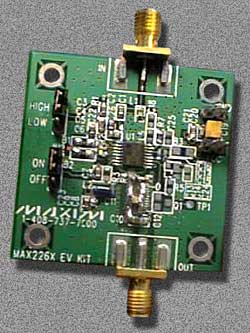Rapid engineering prototypes are actual circuits that Maxim application engineers build in the lab and conduct product testing. They are the starting point for new RF engineering designs. They are not intended as assessment testing tools.

Goal: Use this low-cost CDMA cellular power amplifier (PA) to develop application circuits with good linearity and high power-added efficiency (PAE).
This design tunes the MAX2265 RF power amplifier to a CDMA mobile phone in the cellular band to meet the output power of 28.5dBm and provide -45dBc ACPR1 and 34% PAE. Use the evaluation board for tuning and testing.
The MAX2265 is a linear RF power amplifier designed for IS-95-based CDMA, PDC and IS-136-based TDMA modulation methods in the US cellular band. To improve PAE, MAX2265 provides a structure that continuously adjusts the bias current, which can effectively suppress current feedback. Using this approach, the linearity of the amplifier (that is, the adjacent channel power ratio, ACPR) can be maintained at a relatively high level, while the output power and current consumption will be reduced. Therefore, the expected linearity is maintained within the continuously changing output control range, and the PAE in the low power output mode can be improved.
Schematic of the MAX2265 evaluation lit (PDF, 39kB)
Performance results of the MAX2265
Bill of materials, part 1
Bill of materials, part 2
All reference designs on this site are sourced from major semiconductor manufacturers or collected online for learning and research. The copyright belongs to the semiconductor manufacturer or the original author. If you believe that the reference design of this site infringes upon your relevant rights and interests, please send us a rights notice. As a neutral platform service provider, we will take measures to delete the relevant content in accordance with relevant laws after receiving the relevant notice from the rights holder. Please send relevant notifications to email: bbs_service@eeworld.com.cn.
It is your responsibility to test the circuit yourself and determine its suitability for you. EEWorld will not be liable for direct, indirect, special, incidental, consequential or punitive damages arising from any cause or anything connected to any reference design used.
Supported by EEWorld Datasheet